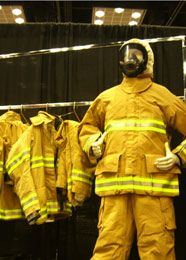By Jamie Thompson
FireRescue1 Editor
 Photo Jamie Thompson The Project HEROES system attracts attention at FDIC in April. |
Couples don’t come much more different than regular turnout gear and a Level A hazmat suit.
But manufacturers have achieved what once seemed impossible by marrying them together to create what some are calling the next generation of PPE.
“These are two very different animals,” said Morning Pride President Bill Grilliot. “One is a very specialized, short-duration suit while the other is used for every fire, for hours at a time.
“You’d think that merging the protective values of those two systems is going to be impossible, but we’ve been able to do it.”
The Morning Pride-designed Project HEROES system is one of two futuristic ensembles that are set to hit the market in the coming months, with Globe’s CB.Ready at a similar stage of development.
As Jeff Stull, FireRescue1’s PPE columnist, outlined in an article earlier this month, the basic premise for the new sets of gear seemed simple enough — a regular structural firefighting ensemble that would function as ordinary turnout clothing and include features to guard against CBRN agents.
However, the actual logistics of putting such contrasting suits and features together required extraordinary amounts of work.
Now, after more than three years’ worth of intense research, development and testing, the two ensembles are moving ever closer toward general production.
Enhanced protection
Project HEROES (Homeland Emergency Response Operational and Equipment Systems) is an initiative led by the IAFF, in conjunction with the IAFC and NIOSH, with Morning Pride as the design leader and manufacturer. The specific aim of the project is “to rapidly develop, prototype and field test structural firefighting PPE with enhanced CBRN protective qualities to account for today’s new threats.”
Grilliot said the team was eagerly awaiting feedback from forthcoming field tests in some of the country’s largest departments — Chicago, New York, Los Angeles and Houston.
“You get a lot more action in some of these big cities, a lot more exposure and a lot more feedback — and feedback is what a field test is for,” he said.
Evaluations for the systems have already taken place in Fairfax County, Va., where firefighters donned them for annual fitness tests.
“Everybody there just raved about it,” Grilliot said. “We had older guys, young recruits, male and female — the whole gamut. Each and every one said they would rather be wearing that gear than the gear they are currently wearing on the job.”
Such responses illustrates the giant leaps forward that have been made since a government organization, the Technical Support Working Group, began sponsoring research projects for the two ensembles back in 2004.
It’s impossible to describe the biggest single challenge encountered during development, Grilliot said.
“Initially when the whole idea was proposed, you’d think it couldn’t be done,” he said.
But, judging from the early feedback from firefighters, both Project HEROES and CB.Ready seemed to have achieved what both manufacturers set out to do.
“One of the first things that was apparent to us when work started was that the firefighter wanted gear that is as much like everyday firefighter suits as possible,” said Mark Mordecai, director of business development at Globe.
“We didn’t want to compromise for that once-in-a-career — and hopefully never — chance of running into a CBRN incident. We didn’t want to sacrifice everyday wearability.”
Meeting requirements
The company, which has worked with North Carolina State University on the project, is currently waiting for the commercial membrane to be certified and another component to meet requirements.
 I think you will see CBRN protection rolled out into various clothing for fire and rescue over the coming years. I think you will see CBRN protection rolled out into various clothing for fire and rescue over the coming years.  | ||
| — Mark Mordecai Globe’s director of business development | ||
Once the certification process has been completed, said Mordecai, extended field tests and trials will get under way.
Both ensembles have been attracting a lot of attention at trade shows over the past couple of years, and FDIC in Indianapolis earlier this month was no different.
“There is always a lot of interest,” Mordecai said. “There’s some people that are really anxious to have the gear now, as we are only one incident away from having a lot of need for this kind of product.
“Other people are unsure if trade offs would have had to be made in order to use this suit compared to the one they’re currently wearing.”
Globe is already looking to incorporate the design into other types of suit, too.
“We expect that once in the field, we’ll roll it out quickly to technical rescue type of gear as well,” Mordecai said.
“There’s a lot of top-level interest and I think you will see CBRN protection rolled out into various clothing for fire and rescue over the coming years.”
Other benefits
While CBRN protection is the obvious focus of the suits, Grilliot said he is hopeful the higher levels of protection they offer could have far-reaching benefits.
“By the firefighter being sealed off, with all the stuff in the smoke and the environment, maybe we’ll be able to reduce the cancer rate in firefighters — wouldn’t that be fantastic?” he said.
“Further down the road, we could find that that the health and safety of the firefighter has been improved just by sealing off the stuff that we’re working with day to day that is burning.”
 Photo Jamie Thompson CB.Ready on display at FDIC. |
Turnout gear in general has seen huge advances in comfort and wearability over the past few years. Designing suits that are less restrictive and allow for better fit and movement has been paramount for the major PPE manufacturers.
The next great leap, said Mordecai, is incorporating components into gear that can monitor a firefighter’s physiological response to conditions on the fireground.
Globe is among the companies working to design such status monitoring into the firefighter ensemble.
This step is, in part, a response to the fact that advances in PPE mean firefighters can get closer than ever to the fire and for longer durations, often with fatal consequences.
“It means the rate of firefighter deaths has remained the same, pretty much 100 every year,” Mordecai said, “and half of them are due to stress and overexertion.”
Building monitoring systems into turnout gear will allow the firefighter and incident command to be alerted to dangerous levels of stress and overexertion, he added.
“The whole idea of what is possible today to protect firefighters has changed dramatically,” Mordecai said.

